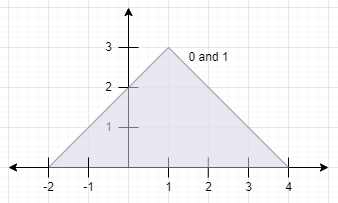LeetCode 2345. Finding the Number of Visible Mountains
原题链接在这里:https://leetcode.com/problems/finding-the-number-of-visible-mountains/description/
题目:
You are given a 0-indexed 2D integer array peaks where peaks[i] = [xi, yi] states that mountain i has a peak at coordinates (xi, yi). A mountain can be described as a right-angled isosceles triangle, with its base along the x-axis and a right angle at its peak. More formally, the gradients of ascending and descending the mountain are 1 and -1 respectively.
A mountain is considered visible if its peak does not lie within another mountain (including the border of other mountains).
Return the number of visible mountains.
Example 1:

Input: peaks = [[2,2],[6,3],[5,4]] Output: 2 Explanation: The diagram above shows the mountains. - Mountain 0 is visible since its peak does not lie within another mountain or its sides. - Mountain 1 is not visible since its peak lies within the side of mountain 2. - Mountain 2 is visible since its peak does not lie within another mountain or its sides. There are 2 mountains that are visible.
Example 2:

Input: peaks = [[1,3],[1,3]] Output: 0 Explanation: The diagram above shows the mountains (they completely overlap). Both mountains are not visible since their peaks lie within each other.
Constraints:
1 <= peaks.length <= 105peaks[i].length == 21 <= xi, yi <= 105
题解:
Write some examples and we can find the pattern that if we sort the peaks, first ascending based on its left start point, then descending on its right end point.
When iterate from left to right, whenever we encounter a bigger right end point, we find a visible mountain.
Note there could be duplicate, thus check if the current and the next peak are the same, if yes, continue.
Time Complexity: O(nlogn). n = peask.length.
Space: O(n). sort worst case uses O(n) space.
AC Java:
1 class Solution { 2 public int visibleMountains(int[][] peaks) { 3 if(peaks == null || peaks.length == 0){ 4 return 0; 5 } 6 7 int n = peaks.length; 8 Arrays.sort(peaks, (a, b) -> { 9 if(a[0] - a[1] == b[0] - b[1]){ 10 return b[0] + b[1] - a[0] - a[1]; 11 } 12 13 return a[0] - a[1] - (b[0] - b[1]); 14 }); 15 16 int res = 0; 17 int maxEnd = Integer.MIN_VALUE; 18 for(int i = 0; i < n; i++){ 19 int x = peaks[i][0]; 20 int y = peaks[i][1]; 21 if(x + y > maxEnd){ 22 maxEnd = x + y; 23 if(i < n - 1 && Arrays.equals(peaks[i], peaks[i + 1])){ 24 continue; 25 } 26 27 res++; 28 } 29 } 30 31 return res; 32 } 33 }
AC Python:
1 class Solution: 2 def visibleMountains(self, peaks: List[List[int]]) -> int: 3 n = len(peaks) 4 5 peaks.sort(key = lambda x: (x[0] - x[1], -(x[0] + x[1]))) 6 7 res = 0 8 maxEnd = -inf 9 10 for i, (x, y) in enumerate(peaks): 11 if x + y > maxEnd: 12 maxEnd = x + y 13 14 if i < n - 1 and peaks[i] == peaks[i+1]: 15 continue 16 17 res += 1 18 19 return res





【推荐】国内首个AI IDE,深度理解中文开发场景,立即下载体验Trae
【推荐】编程新体验,更懂你的AI,立即体验豆包MarsCode编程助手
【推荐】抖音旗下AI助手豆包,你的智能百科全书,全免费不限次数
【推荐】轻量又高性能的 SSH 工具 IShell:AI 加持,快人一步
· 阿里最新开源QwQ-32B,效果媲美deepseek-r1满血版,部署成本又又又降低了!
· 开源Multi-agent AI智能体框架aevatar.ai,欢迎大家贡献代码
· Manus重磅发布:全球首款通用AI代理技术深度解析与实战指南
· 被坑几百块钱后,我竟然真的恢复了删除的微信聊天记录!
· AI技术革命,工作效率10个最佳AI工具
2017-03-01 LeetCode 450. Delete Node in a BST